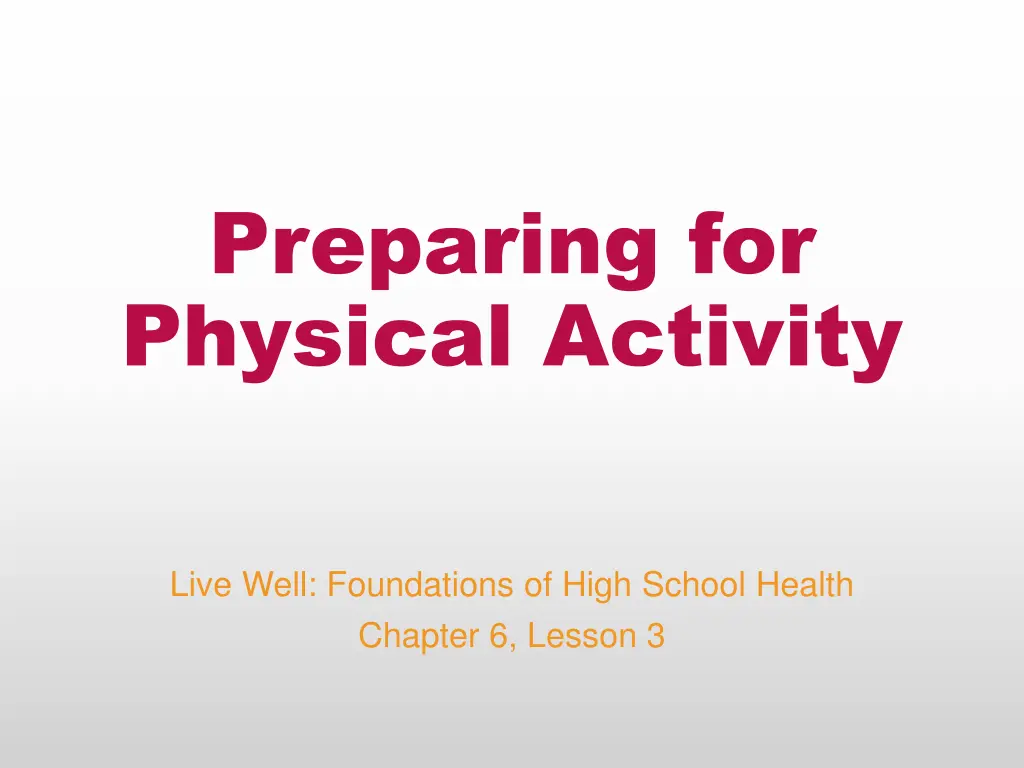
Physical Activity and Wellness: Foundations of a Healthy Life
Engage in physical activities throughout your life for a healthier lifestyle. Learn about the importance of warm-ups, workouts, and cool-downs, as well as the benefits of staying active in individual, dual, or team sports. Discover the significance of protective equipment and injury prevention strategies to ensure a safe and active life.
Download Presentation

Please find below an Image/Link to download the presentation.
The content on the website is provided AS IS for your information and personal use only. It may not be sold, licensed, or shared on other websites without obtaining consent from the author. If you encounter any issues during the download, it is possible that the publisher has removed the file from their server.
You are allowed to download the files provided on this website for personal or commercial use, subject to the condition that they are used lawfully. All files are the property of their respective owners.
The content on the website is provided AS IS for your information and personal use only. It may not be sold, licensed, or shared on other websites without obtaining consent from the author.
E N D
Presentation Transcript
Preparing for Physical Activity Live Well: Foundations of High School Health Chapter 6, Lesson 3
Write About It What is your favorite physical activity and why? Is it something you can do throughout your life? Can you do it anywhere? Do you need special equipment for it?
Can you . . . Describe the three parts of a workout? Identify three benefits of being physically active throughout your life? Explain two things an individual, dual, or team sport can teach you? Analyze the importance of three pieces of protective equipment you should wear when being physically active? List three strategies you think are important for preventing an injury?
Preparing for Activity or Workout Whether you are just starting to be physically active or have a regular routine, you should always begin slowly and progressively work into your activity for the day. Your activity should always include three parts: A warm-up activity The focus of your workout A cool-down activity
Warm-Up, Workout, and Cool-Down Your warm-up should include large muscle movements that get your whole body moving. You want to slowly increase your heart rate so you will be ready for your activity. Many warm-ups last 5 to 10 minutes and involve dynamic stretching. Your workout will be determined by what you are trying to improve or what you re training for. A cool-down is used to slow your body down and give it time to adjust when ending an activity.
Getting Active and Staying Active Throughout Your Life Consistent physical activity in all health-related fitness areas is not only good for you in the moment but also has lifelong benefits. Staying active later in life helps to maintain the ability to live alone and reduces the risk of falling and fracturing bones. It also helps improve your muscle strength and joint mobility and lowers the risk of high blood pressure and strokes.
Individual, Dual, and Team Sports An individual sport is played by one person, such as swimming or golf. A dual sport is played by two people, such as tennis doubles or pickleball. Individual and dual sports promote resilience and self-motivation. A team sport is played by a group of people, such as basketball or ultimate frisbee. Team sports teach you to work with others and be a good sport during competition.
Dressing for Physical Activity Always make sure you are dressed for the activity you are participating in and have the proper equipment to keep you safe. Wear comfortable clothes so you can move freely. Dress in layers so you can take layers off if you get too warm and put them back on if you get cold. Wear proper socks to prevent blisters. Wear proper shoes for the activity you are participating in.
Physical Activity and Using Protective Equipment Many activities you are involved with may have protective equipment to keep you safe and help prevent injuries. This equipment includes: helmets (for bike riding, skateboarding, snow skiing, football, baseball, and lacrosse); mouth guards (for football, basketball, lacrosse, and rugby); knee pads, wrist pads, and elbow pads (for skateboarding, snowboarding, ice hockey, and football); and face masks (for softball and baseball catchers and lacrosse players).
Preventing Injuries While Being Active Make sure you are using proper technique when exercising. Vary your activity so that you aren t using the same muscle groups every day. Don t play through pain which often turns a minor injury into a major injury. Warm up and cool down properly. Stay hydrated by drinking water regularly before, during, and after your activity.
Exercising in Hot Weather Being active in hot weather can lead to heat-related emergencies caused by overexposure to heat or dehydration. Dehydration occurs when you lose more fluid than you take in. To prevent heat-related emergencies, wear light-colored and lightweight clothing; avoid exercising in high heat and humidity; drink water before, during, and after exercising; and rest frequently in the shade and use cool towels to help you keep cool.
Exercising in Cold and Wet Weather Being active in cold and wet weather can lead to cold- related emergencies caused by overexposure to cold. Overexposure can lead to frostbite or hypothermia. To prevent cold-related emergencies wear several layers of clothing; wear clothing to protect your head, hands, face, ears, and feet from the cold to prevent frostbite; drink water before, during, and after exercising to maintain proper dehydration; and try to avoid exercising in cold and wet weather.
Skill-Building Challenge Think about who influences you to wear or not to wear protective gear like helmets, mouth guards, face masks, and protective pads. List four influences. Mark them with a star if they are a positive influence and mark them with a check mark if they are a negative one. Explain briefly how each influence affects you.
